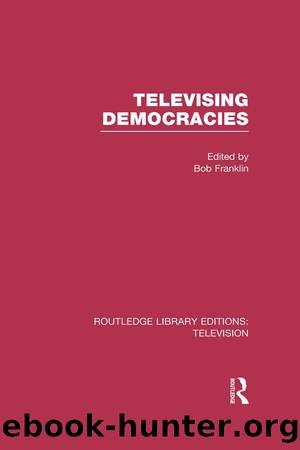Televising Democracies by Bob Franklin

Author:Bob Franklin [Franklin, Bob]
Language: eng
Format: epub
Google: heNLzQEACAAJ
Publisher: Routledge
Published: 2013-01-15T04:47:18+00:00
CONCLUSIONS
Members appear to have been satisfied that the experiment in televising the House of Commons was successful in presenting a full, balanced and fair account of the work of the House to the viewing public. Their decision to make the cameras a permanent fixture (by a majority of 99) must be interpreted as offering some endorsement of broadcasters' achievements in this respect.
Coverage of the Commons was certainly âfullâ, when measured by the substantive use of parliamentary items in news broadcasts, and review programmes created to provide more detailed attention to the work of the House. Coverage could, of course, be enhanced further. Audience figures attained by regular live broadcasts suggest that there may be considerable potential for a dedicated channel, similar to C-SPAN in the USA, devoted to Parliament. Austin Mitchell, Roger Gale and Charles Kennedy each advocate such a development.
Full coverage was also reflected in the breadth of parliamentary events reported, and the attention given to backbenchers. The reporting of Select Committee hearings and the lack of undue emphasis on Prime Minister's Questions were indicative of the range of proceedings presented in programmes. Few aspects of the work of the House escaped broadcasters' attention. The experimental period witnessed the reporting of questions, the passage of legislation, discussion of Private Members' Bills, Private Bills, Standing Committees, emergency debate applications, Opposition-initiated debates, adjournment debates, the presentation of petitions and countless points of order. The House of Lords, while suffering relative neglect as a consequence of the rival attractions of the Commons, still made regular appearances in review programmes. Backbenchers enjoyed considerable prominence in all types of programming but were especially evident in regional output. A powerful speech or a probing question would be reported, whoever the protagonist. Indeed, televising saw the emergence into the public gaze of relatively unknown MPs such as the stentorian Frank Haynes.
The question of balance is, as always, more problematic. The amply documented prevalence of Conservative MPs above others was perhaps inevitable given the nature of both parliamentary procedure and journalistic attitudes towards the Government. But the marginalization of the Liberal Democrats and the other numerically small parliamentary parties perhaps offers greater cause for concern. Any mathematical formula for the allocation of broadcast time to the various parties is fraught with difficulties and, of course, more coverage does not necessarily imply more favourable coverage. Derisory coverage, however, is a different matter, for it implies that ignored voices do not count. In a plural society, it can never be wrong to admit more and diverse voices into the debate.
The advocates of televising the Commons have made ambitious predictions concerning its likely effects. Speaking as long ago as 1959, Nye Bevan argued that television would âre-establish intelligent communication between the House of Commons and the electorate as a wholeâ (HC Debs 1959: col. 867). Such hopes rest on the ability of broadcasters to treat the Commons responsibly, and to report proceedings in a full, balanced and fair manner. The evidence from the experimental period suggests that this requirement was achieved.
Download
This site does not store any files on its server. We only index and link to content provided by other sites. Please contact the content providers to delete copyright contents if any and email us, we'll remove relevant links or contents immediately.
| Anthropology | Archaeology |
| Philosophy | Politics & Government |
| Social Sciences | Sociology |
| Women's Studies |
Born to Run: by Christopher McDougall(7025)
The Leavers by Lisa Ko(6873)
iGen by Jean M. Twenge(5320)
Sapiens by Yuval Noah Harari(5259)
The Kite Runner by Khaled Hosseini(5034)
Spare by Prince Harry The Duke of Sussex(4991)
Bullshit Jobs by David Graeber(3990)
Machine Learning at Scale with H2O by Gregory Keys | David Whiting(3948)
Never by Ken Follett(3698)
Goodbye Paradise(3661)
Livewired by David Eagleman(3619)
Fairy Tale by Stephen King(3150)
Harry Potter 4 - Harry Potter and The Goblet of Fire by J.K.Rowling(2937)
A Dictionary of Sociology by Unknown(2923)
The Social Psychology of Inequality by Unknown(2895)
The Club by A.L. Brooks(2809)
Will by Will Smith(2729)
0041152001443424520 .pdf by Unknown(2722)
People of the Earth: An Introduction to World Prehistory by Dr. Brian Fagan & Nadia Durrani(2672)
